AI Enhances Writing: A Guide to Rubrics, ChatGPT and Bard
In today's dynamic educational environment, the use of generative AI tools like ChatGPT and Google Bard can revolutionize how students approach and reflect on their writing. This article delves into practical strategies for integrating rubrics with these AI platforms, aiming to enhance AI literacy and promote metacognitive reflection on writing quality. By incorporating these tools, educators can guide students toward a deeper understanding of effective communication and critical self-assessment.
Key Points
- Use rubrics to establish clear expectations for writing tasks.
- Harness ChatGPT and Bard to evaluate writing against rubric standards.
- Encourage students to reflect on their writing through AI-generated feedback.
- Build AI literacy by exploring the strengths and limitations of generative AI tools.
- Facilitate discussions on the reliability and fairness of assessment criteria.
Understanding Generative AI in Writing Education
The Role of Rubrics in Evaluating Writing
Rubrics are invaluable in education, offering a structured way to assess student work. They break down complex tasks into manageable parts, helping students grasp what's expected and allowing them to evaluate their own progress. A well-crafted rubric can make grading more objective and transparent, ensuring fairness and consistency. Key components of a rubric include categories, performance levels, and detailed descriptions of what each level means.
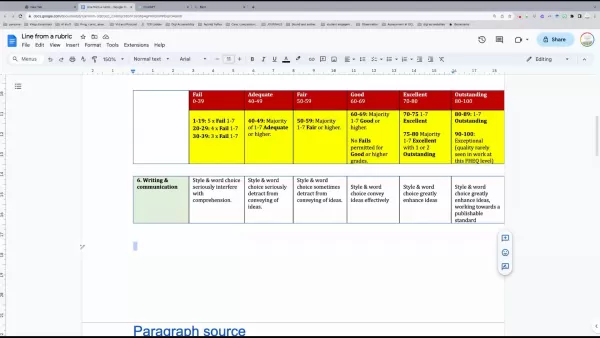
For instance, a writing rubric might cover:
- Content: How accurate, relevant, and deep the information is.
- Organization: The structure, flow, and coherence of the writing.
- Style: Clarity, tone, and voice of the writing.
- Mechanics: Grammar, spelling, and punctuation.
Each category is rated on a scale:
- Excellent: Exceeds expectations in all criteria.
- Good: Meets all criteria.
- Fair: Meets some criteria but needs improvement.
- Poor: Does not meet criteria.
With rubrics, educators provide a clear path to success, helping students pinpoint areas for improvement and elevate their writing quality.
Introducing ChatGPT and Google Bard for AI-Assisted Writing Analysis
ChatGPT and Google Bard are cutting-edge generative AI tools that can analyze and offer feedback on writing. Utilizing natural language processing (NLP), they understand and produce text that's remarkably human-like, making them essential for both educators and students. ChatGPT, developed by OpenAI, is great for generating creative and informative content, while Google Bard, part of the Google ecosystem, provides real-time information access and collaborative tools. These platforms can:
- Analyze text to pinpoint strengths and areas for improvement.
- Offer feedback on style, grammar, and organization.
- Generate examples to showcase effective writing techniques.
- Spark discussions on writing quality and assessment criteria.
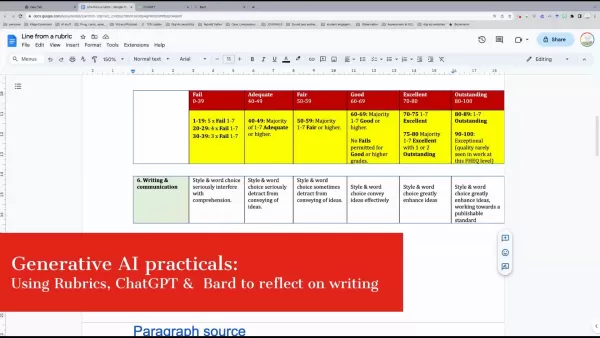
By weaving ChatGPT and Bard into the writing process, educators can boost students' AI literacy, helping them grasp the potential and boundaries of AI in writing evaluation and enhancement. This also encourages metacognitive reflection, as students scrutinize the AI's feedback and compare it with their own assessments.
Practical Strategies for Reflecting on Writing with AI Tools
Isolating Rubric Elements for Focused Analysis
To effectively blend rubrics with AI tools, it's helpful to focus on specific rubric elements. This method lets students dive deep into particular writing aspects, like clarity or style, rather than tackling the whole rubric at once.
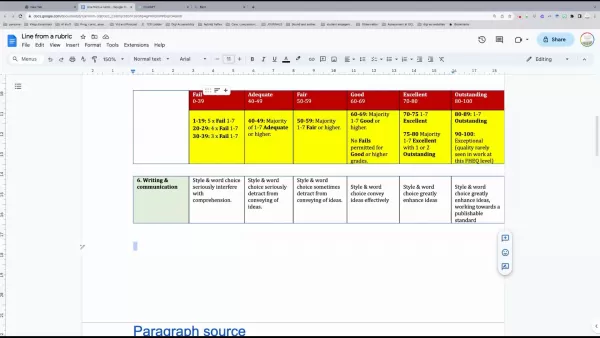
For example, you might focus on 'Style and Word Choice' instead of the entire rubric. This targeted approach helps students appreciate the subtleties of effective communication and how word choice affects writing quality.
Isolating rubric elements also prompts students to compare AI feedback with their self-assessments, deepening their understanding of their strengths and weaknesses. This encourages critical thinking and metacognitive reflection, as students weigh the validity and objectivity of the AI's feedback.
Step Description 1. Select a Category Choose a specific rubric category, like 'Organization' or 'Clarity.' 2. Analyze Writing Ask ChatGPT or Bard to evaluate a writing sample based on the chosen category. 3. Compare Feedback Compare the AI's feedback with your self-assessment. 4. Discuss Results Discuss the similarities and differences between the AI's feedback and your assessment, promoting critical thinking about writing quality and criteria. 5. Refine Writing Use insights from the AI and self-assessment to refine your writing, focusing on specific areas for improvement. This iterative process enhances writing quality and AI literacy.
Prompting AI for Grade Band Assessment and Rewriting
A powerful way to enhance AI literacy and metacognitive reflection is to ask ChatGPT or Bard to assess a writing sample against a rubric and then rewrite it for different grade bands. This shows students tangible examples of how writing quality varies across performance levels.
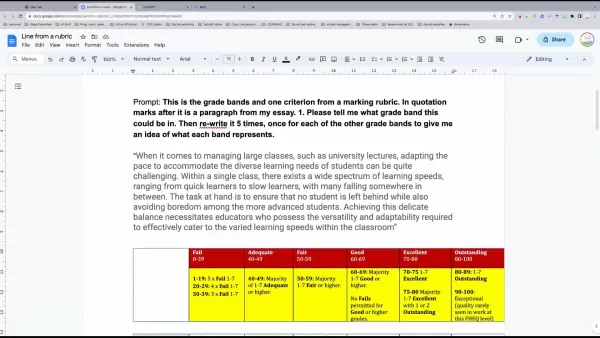
Here's how to implement this technique:
- Give the AI a writing sample and the rubric.
- Ask the AI to evaluate the sample and determine its grade band.
- Instruct the AI to rewrite the sample for other grade bands, illustrating how writing quality changes at each level.
By comparing the original with AI-generated rewrites, students gain a clearer understanding of rubric criteria and their impact on writing. This exercise fosters critical thinking about writing quality, style, and word choice, leading to a more nuanced grasp of effective communication. An example prompt could be:
- "This is the grade bands and one criterion from a marking rubric. In quotation marks after it is a paragraph from my essay. 1. Please tell me what grade band this could be in. Then re-write it 5 times, once for each of the other grade bands to give me an idea of what each band represents."
Exploring different versions of the same paragraph helps students understand what makes writing excellent, good, fair, adequate, or failing. They learn to pinpoint areas for improvement and develop strategies to enhance their writing.
Step-by-Step Guide: Using Rubrics, ChatGPT, and Bard
Step 1: Create a Writing Sample
Start by crafting a writing sample, such as an essay paragraph or short report. Make sure it reflects your writing abilities.
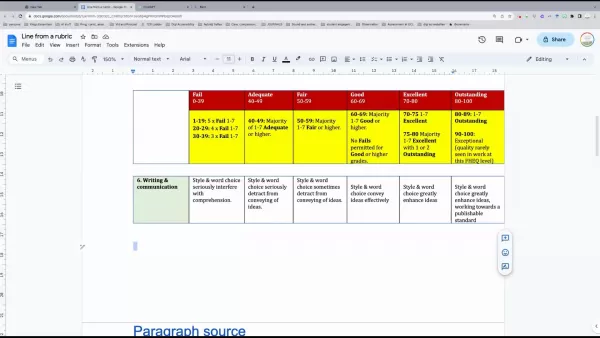
- Choose a topic you're interested in.
- Brainstorm and outline your ideas.
- Write a clear and concise sample that showcases your style.
- Review and revise to ensure it meets basic standards.
Step 2: Select a Relevant Rubric
Select a rubric that aligns with the criteria for evaluating your writing sample. It could be one provided by your instructor or found online.
- Get familiar with the rubric's categories and performance levels.
- Identify the most relevant elements for your sample.
- Consider the weighting of different categories to focus your analysis.
Step 3: Prompt ChatGPT or Bard for Assessment
Provide ChatGPT or Bard with your writing sample and the rubric. Ask the AI to assess your sample against the rubric and give feedback on its strengths and weaknesses.
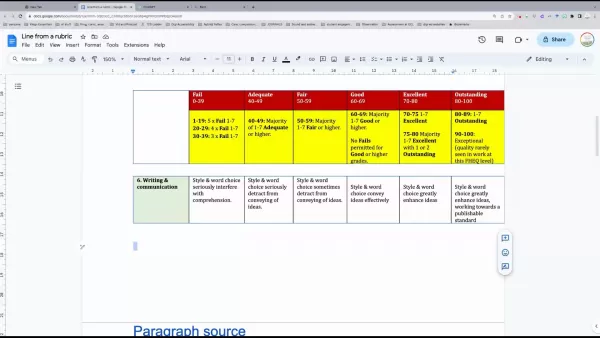
- Copy and paste your sample and rubric into the AI platform.
- Use clear and specific prompts to guide the AI's analysis.
- Ask the AI to identify the corresponding grade band.
- Request specific suggestions for improvement based on rubric criteria.
Step 4: Analyze and Compare Feedback
Carefully review the feedback from ChatGPT or Bard. Compare it with your self-assessment and note any similarities or differences.
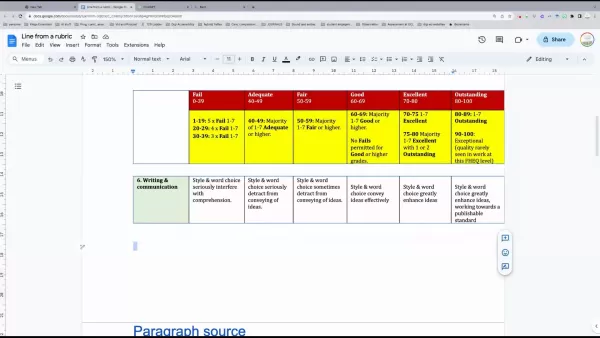
- Evaluate the AI's feedback and its validity.
- Identify areas where the AI's assessment differs from yours.
- Reflect on these differences and consider AI's limitations in evaluating writing.
- Discuss your findings with peers or instructors for further insights.
Step 5: Refine Your Writing
Use the insights from AI feedback and your self-assessment to refine your writing sample. Focus on specific areas for improvement and implement the AI's suggestions.
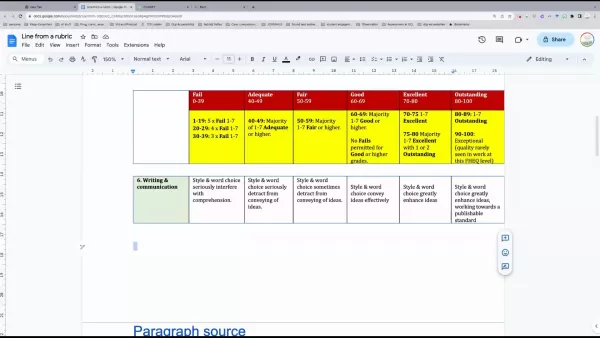
- Rewrite sentences or paragraphs to improve clarity, organization, or style.
- Adjust word choices to better convey your ideas.
- Correct any grammatical or mechanical errors.
- Seek feedback from peers or instructors to validate your revisions.
Pricing
ChatGPT
ChatGPT offers various pricing plans tailored to different needs. The free plan provides limited access to basic features. The Plus plan, at $20 per month, offers faster response times, priority access to new features, and general access during peak times. For businesses, the Enterprise plan includes advanced data privacy, customization, and team collaboration features, with pricing customized to specific business needs and usage.
Google Bard
Google Bard is currently an experimental service, free for users with a Google account. Future premium features or subscription plans may be introduced, but for now, users can access Bard's AI capabilities at no cost.
Pros and Cons
Pros
- Delivers consistent and objective feedback.
- Enhances AI literacy and metacognitive reflection.
- Offers personalized and targeted guidance for improvement.
- Facilitates discussions about writing quality and assessment criteria.
Cons
- May lack a nuanced understanding of context and creativity.
- Requires careful prompting to ensure relevant feedback.
- May promote over-reliance on AI and undermine critical thinking skills.
- Raises ethical concerns about academic integrity and originality.
Core Features
ChatGPT
ChatGPT offers a range of powerful features:
- Text Generation: Creates human-like text for various applications, including content creation, chatbots, and code generation.
- Language Understanding: Comprehends complex questions and requests, providing accurate and relevant responses.
- Customization: Can be fine-tuned for specific tasks and domains, allowing for tailored AI solutions.
- Integration: Easily integrates with other tools and platforms via APIs, enabling seamless workflow automation.
Google Bard
Google Bard's features include:
- Real-time Information Access: Integrated with Google Search, providing real-time access to vast amounts of information.
- Collaborative Features: Allows multiple users to collaborate on writing projects and share feedback seamlessly.
- Creative Expression: Can generate creative content, including poems, stories, and scripts.
- Integration with Google Workspace: Works seamlessly with Google Docs, Sheets, and other Workspace apps.
Use Cases
ChatGPT
ChatGPT is widely used in content creation, customer service, and education. It helps businesses automate customer support, generates engaging content for marketing campaigns, and assists educators in providing personalized feedback to students. It's also utilized for coding, capable of writing and explaining code in various programming languages.
Google Bard
Google Bard excels in scenarios requiring real-time access to information, such as research, brainstorming, and content enhancement. It aids journalists in gathering data quickly, helps marketers refine campaigns with real-time insights, and assists creative writers in overcoming writer's block with AI-generated suggestions. Bard's integration with Google Workspace enables smooth collaboration and efficient workflows across tasks.
FAQ
Can ChatGPT and Google Bard replace human assessment of writing?
While ChatGPT and Google Bard can provide valuable feedback and analysis, they cannot entirely replace human assessment of writing. AI tools can identify patterns and suggest improvements, but they may lack the nuanced understanding of context, creativity, and personal expression that human evaluators possess. It's best to use these AI tools as supplements to human assessment, rather than replacements.
Related Questions
How can educators integrate AI tools into their writing curriculum effectively?
Educators can integrate AI tools into their writing curriculum by:
- Providing clear guidelines and expectations for using AI in writing.
- Encouraging students to critically evaluate the AI's feedback and compare it to their own self-assessments.
- Facilitating discussions about the ethical implications of using AI in writing.
- Designing assignments that require students to use AI tools to enhance their writing skills, rather than replace them.
- Focusing on developing students' AI literacy and metacognitive reflection skills.
Related article
 AI-Powered Cover Letters: Expert Guide for Journal Submissions
In today's competitive academic publishing environment, crafting an effective cover letter can make the crucial difference in your manuscript's acceptance. Discover how AI-powered tools like ChatGPT can streamline this essential task, helping you cre
AI-Powered Cover Letters: Expert Guide for Journal Submissions
In today's competitive academic publishing environment, crafting an effective cover letter can make the crucial difference in your manuscript's acceptance. Discover how AI-powered tools like ChatGPT can streamline this essential task, helping you cre
 US to Sanction Foreign Officials Over Social Media Regulations
US Takes Stand Against Global Digital Content Regulations
The State Department issued a sharp diplomatic rebuke this week targeting European digital governance policies, signaling escalating tensions over control of online platforms. Secretary Marco
US to Sanction Foreign Officials Over Social Media Regulations
US Takes Stand Against Global Digital Content Regulations
The State Department issued a sharp diplomatic rebuke this week targeting European digital governance policies, signaling escalating tensions over control of online platforms. Secretary Marco
 Ultimate Guide to AI-Powered YouTube Video Summarizers
In our information-rich digital landscape, AI-powered YouTube video summarizers have become indispensable for efficient content consumption. This in-depth guide explores how to build a sophisticated summarization tool using cutting-edge NLP technolog
Comments (3)
0/200
Ultimate Guide to AI-Powered YouTube Video Summarizers
In our information-rich digital landscape, AI-powered YouTube video summarizers have become indispensable for efficient content consumption. This in-depth guide explores how to build a sophisticated summarization tool using cutting-edge NLP technolog
Comments (3)
0/200
![JohnHarris]() JohnHarris
JohnHarris
 September 30, 2025 at 2:30:50 PM EDT
September 30, 2025 at 2:30:50 PM EDT
這篇文章真的很實用!我最近也在用ChatGPT幫學生改作文,但一直不知道怎麼訂出明確的評分標準。期待裡面提到的rubrics整合技巧能讓AI輔助寫作更有效~ 😊


 0
0
![RaymondAdams]() RaymondAdams
RaymondAdams
 August 4, 2025 at 1:00:59 PM EDT
August 4, 2025 at 1:00:59 PM EDT
This article really opened my eyes to how AI can boost writing skills! I love the idea of combining rubrics with ChatGPT—makes me wonder if teachers will start using this to grade essays. 🤔 Cool stuff, but I hope it doesn’t make writing too mechanical.


 0
0
![PaulLewis]() PaulLewis
PaulLewis
 August 4, 2025 at 2:48:52 AM EDT
August 4, 2025 at 2:48:52 AM EDT
This article's take on AI in writing is pretty cool! I love how it breaks down using ChatGPT with rubrics. Makes me wonder if AI could one day grade essays better than my profs 😅. Anyone tried this in class yet?


 0
0
In today's dynamic educational environment, the use of generative AI tools like ChatGPT and Google Bard can revolutionize how students approach and reflect on their writing. This article delves into practical strategies for integrating rubrics with these AI platforms, aiming to enhance AI literacy and promote metacognitive reflection on writing quality. By incorporating these tools, educators can guide students toward a deeper understanding of effective communication and critical self-assessment.
Key Points
- Use rubrics to establish clear expectations for writing tasks.
- Harness ChatGPT and Bard to evaluate writing against rubric standards.
- Encourage students to reflect on their writing through AI-generated feedback.
- Build AI literacy by exploring the strengths and limitations of generative AI tools.
- Facilitate discussions on the reliability and fairness of assessment criteria.
Understanding Generative AI in Writing Education
The Role of Rubrics in Evaluating Writing
Rubrics are invaluable in education, offering a structured way to assess student work. They break down complex tasks into manageable parts, helping students grasp what's expected and allowing them to evaluate their own progress. A well-crafted rubric can make grading more objective and transparent, ensuring fairness and consistency. Key components of a rubric include categories, performance levels, and detailed descriptions of what each level means.

For instance, a writing rubric might cover:
- Content: How accurate, relevant, and deep the information is.
- Organization: The structure, flow, and coherence of the writing.
- Style: Clarity, tone, and voice of the writing.
- Mechanics: Grammar, spelling, and punctuation.
Each category is rated on a scale:
- Excellent: Exceeds expectations in all criteria.
- Good: Meets all criteria.
- Fair: Meets some criteria but needs improvement.
- Poor: Does not meet criteria.
With rubrics, educators provide a clear path to success, helping students pinpoint areas for improvement and elevate their writing quality.
Introducing ChatGPT and Google Bard for AI-Assisted Writing Analysis
ChatGPT and Google Bard are cutting-edge generative AI tools that can analyze and offer feedback on writing. Utilizing natural language processing (NLP), they understand and produce text that's remarkably human-like, making them essential for both educators and students. ChatGPT, developed by OpenAI, is great for generating creative and informative content, while Google Bard, part of the Google ecosystem, provides real-time information access and collaborative tools. These platforms can:
- Analyze text to pinpoint strengths and areas for improvement.
- Offer feedback on style, grammar, and organization.
- Generate examples to showcase effective writing techniques.
- Spark discussions on writing quality and assessment criteria.

By weaving ChatGPT and Bard into the writing process, educators can boost students' AI literacy, helping them grasp the potential and boundaries of AI in writing evaluation and enhancement. This also encourages metacognitive reflection, as students scrutinize the AI's feedback and compare it with their own assessments.
Practical Strategies for Reflecting on Writing with AI Tools
Isolating Rubric Elements for Focused Analysis
To effectively blend rubrics with AI tools, it's helpful to focus on specific rubric elements. This method lets students dive deep into particular writing aspects, like clarity or style, rather than tackling the whole rubric at once.

For example, you might focus on 'Style and Word Choice' instead of the entire rubric. This targeted approach helps students appreciate the subtleties of effective communication and how word choice affects writing quality.
Isolating rubric elements also prompts students to compare AI feedback with their self-assessments, deepening their understanding of their strengths and weaknesses. This encourages critical thinking and metacognitive reflection, as students weigh the validity and objectivity of the AI's feedback.
| Step | Description |
|---|---|
| 1. Select a Category | Choose a specific rubric category, like 'Organization' or 'Clarity.' |
| 2. Analyze Writing | Ask ChatGPT or Bard to evaluate a writing sample based on the chosen category. |
| 3. Compare Feedback | Compare the AI's feedback with your self-assessment. |
| 4. Discuss Results | Discuss the similarities and differences between the AI's feedback and your assessment, promoting critical thinking about writing quality and criteria. |
| 5. Refine Writing | Use insights from the AI and self-assessment to refine your writing, focusing on specific areas for improvement. This iterative process enhances writing quality and AI literacy. |
Prompting AI for Grade Band Assessment and Rewriting
A powerful way to enhance AI literacy and metacognitive reflection is to ask ChatGPT or Bard to assess a writing sample against a rubric and then rewrite it for different grade bands. This shows students tangible examples of how writing quality varies across performance levels.

Here's how to implement this technique:
- Give the AI a writing sample and the rubric.
- Ask the AI to evaluate the sample and determine its grade band.
- Instruct the AI to rewrite the sample for other grade bands, illustrating how writing quality changes at each level.
By comparing the original with AI-generated rewrites, students gain a clearer understanding of rubric criteria and their impact on writing. This exercise fosters critical thinking about writing quality, style, and word choice, leading to a more nuanced grasp of effective communication. An example prompt could be:
- "This is the grade bands and one criterion from a marking rubric. In quotation marks after it is a paragraph from my essay. 1. Please tell me what grade band this could be in. Then re-write it 5 times, once for each of the other grade bands to give me an idea of what each band represents."
Exploring different versions of the same paragraph helps students understand what makes writing excellent, good, fair, adequate, or failing. They learn to pinpoint areas for improvement and develop strategies to enhance their writing.
Step-by-Step Guide: Using Rubrics, ChatGPT, and Bard
Step 1: Create a Writing Sample
Start by crafting a writing sample, such as an essay paragraph or short report. Make sure it reflects your writing abilities.

- Choose a topic you're interested in.
- Brainstorm and outline your ideas.
- Write a clear and concise sample that showcases your style.
- Review and revise to ensure it meets basic standards.
Step 2: Select a Relevant Rubric
Select a rubric that aligns with the criteria for evaluating your writing sample. It could be one provided by your instructor or found online.
- Get familiar with the rubric's categories and performance levels.
- Identify the most relevant elements for your sample.
- Consider the weighting of different categories to focus your analysis.
Step 3: Prompt ChatGPT or Bard for Assessment
Provide ChatGPT or Bard with your writing sample and the rubric. Ask the AI to assess your sample against the rubric and give feedback on its strengths and weaknesses.

- Copy and paste your sample and rubric into the AI platform.
- Use clear and specific prompts to guide the AI's analysis.
- Ask the AI to identify the corresponding grade band.
- Request specific suggestions for improvement based on rubric criteria.
Step 4: Analyze and Compare Feedback
Carefully review the feedback from ChatGPT or Bard. Compare it with your self-assessment and note any similarities or differences.

- Evaluate the AI's feedback and its validity.
- Identify areas where the AI's assessment differs from yours.
- Reflect on these differences and consider AI's limitations in evaluating writing.
- Discuss your findings with peers or instructors for further insights.
Step 5: Refine Your Writing
Use the insights from AI feedback and your self-assessment to refine your writing sample. Focus on specific areas for improvement and implement the AI's suggestions.

- Rewrite sentences or paragraphs to improve clarity, organization, or style.
- Adjust word choices to better convey your ideas.
- Correct any grammatical or mechanical errors.
- Seek feedback from peers or instructors to validate your revisions.
Pricing
ChatGPT
ChatGPT offers various pricing plans tailored to different needs. The free plan provides limited access to basic features. The Plus plan, at $20 per month, offers faster response times, priority access to new features, and general access during peak times. For businesses, the Enterprise plan includes advanced data privacy, customization, and team collaboration features, with pricing customized to specific business needs and usage.
Google Bard
Google Bard is currently an experimental service, free for users with a Google account. Future premium features or subscription plans may be introduced, but for now, users can access Bard's AI capabilities at no cost.
Pros and Cons
Pros
- Delivers consistent and objective feedback.
- Enhances AI literacy and metacognitive reflection.
- Offers personalized and targeted guidance for improvement.
- Facilitates discussions about writing quality and assessment criteria.
Cons
- May lack a nuanced understanding of context and creativity.
- Requires careful prompting to ensure relevant feedback.
- May promote over-reliance on AI and undermine critical thinking skills.
- Raises ethical concerns about academic integrity and originality.
Core Features
ChatGPT
ChatGPT offers a range of powerful features:
- Text Generation: Creates human-like text for various applications, including content creation, chatbots, and code generation.
- Language Understanding: Comprehends complex questions and requests, providing accurate and relevant responses.
- Customization: Can be fine-tuned for specific tasks and domains, allowing for tailored AI solutions.
- Integration: Easily integrates with other tools and platforms via APIs, enabling seamless workflow automation.
Google Bard
Google Bard's features include:
- Real-time Information Access: Integrated with Google Search, providing real-time access to vast amounts of information.
- Collaborative Features: Allows multiple users to collaborate on writing projects and share feedback seamlessly.
- Creative Expression: Can generate creative content, including poems, stories, and scripts.
- Integration with Google Workspace: Works seamlessly with Google Docs, Sheets, and other Workspace apps.
Use Cases
ChatGPT
ChatGPT is widely used in content creation, customer service, and education. It helps businesses automate customer support, generates engaging content for marketing campaigns, and assists educators in providing personalized feedback to students. It's also utilized for coding, capable of writing and explaining code in various programming languages.
Google Bard
Google Bard excels in scenarios requiring real-time access to information, such as research, brainstorming, and content enhancement. It aids journalists in gathering data quickly, helps marketers refine campaigns with real-time insights, and assists creative writers in overcoming writer's block with AI-generated suggestions. Bard's integration with Google Workspace enables smooth collaboration and efficient workflows across tasks.
FAQ
Can ChatGPT and Google Bard replace human assessment of writing?
While ChatGPT and Google Bard can provide valuable feedback and analysis, they cannot entirely replace human assessment of writing. AI tools can identify patterns and suggest improvements, but they may lack the nuanced understanding of context, creativity, and personal expression that human evaluators possess. It's best to use these AI tools as supplements to human assessment, rather than replacements.
Related Questions
How can educators integrate AI tools into their writing curriculum effectively?
Educators can integrate AI tools into their writing curriculum by:
- Providing clear guidelines and expectations for using AI in writing.
- Encouraging students to critically evaluate the AI's feedback and compare it to their own self-assessments.
- Facilitating discussions about the ethical implications of using AI in writing.
- Designing assignments that require students to use AI tools to enhance their writing skills, rather than replace them.
- Focusing on developing students' AI literacy and metacognitive reflection skills.
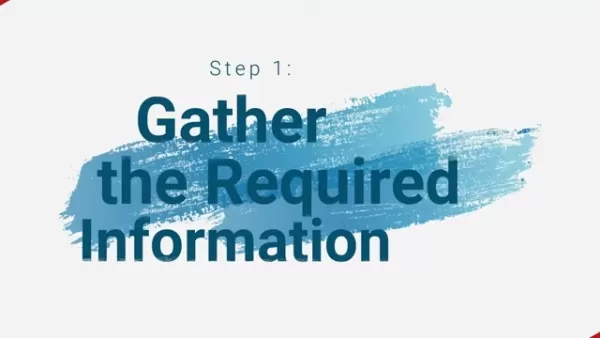 AI-Powered Cover Letters: Expert Guide for Journal Submissions
In today's competitive academic publishing environment, crafting an effective cover letter can make the crucial difference in your manuscript's acceptance. Discover how AI-powered tools like ChatGPT can streamline this essential task, helping you cre
AI-Powered Cover Letters: Expert Guide for Journal Submissions
In today's competitive academic publishing environment, crafting an effective cover letter can make the crucial difference in your manuscript's acceptance. Discover how AI-powered tools like ChatGPT can streamline this essential task, helping you cre
 US to Sanction Foreign Officials Over Social Media Regulations
US Takes Stand Against Global Digital Content Regulations
The State Department issued a sharp diplomatic rebuke this week targeting European digital governance policies, signaling escalating tensions over control of online platforms. Secretary Marco
US to Sanction Foreign Officials Over Social Media Regulations
US Takes Stand Against Global Digital Content Regulations
The State Department issued a sharp diplomatic rebuke this week targeting European digital governance policies, signaling escalating tensions over control of online platforms. Secretary Marco
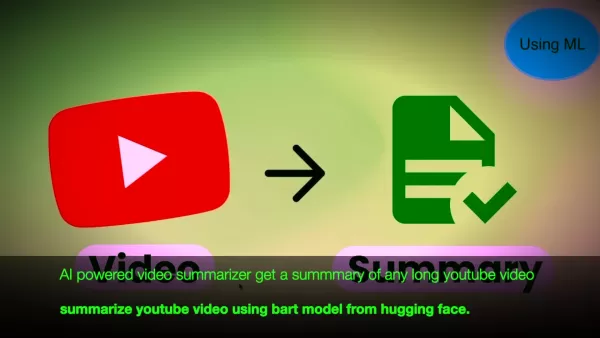 Ultimate Guide to AI-Powered YouTube Video Summarizers
In our information-rich digital landscape, AI-powered YouTube video summarizers have become indispensable for efficient content consumption. This in-depth guide explores how to build a sophisticated summarization tool using cutting-edge NLP technolog
Ultimate Guide to AI-Powered YouTube Video Summarizers
In our information-rich digital landscape, AI-powered YouTube video summarizers have become indispensable for efficient content consumption. This in-depth guide explores how to build a sophisticated summarization tool using cutting-edge NLP technolog
 September 30, 2025 at 2:30:50 PM EDT
September 30, 2025 at 2:30:50 PM EDT
這篇文章真的很實用!我最近也在用ChatGPT幫學生改作文,但一直不知道怎麼訂出明確的評分標準。期待裡面提到的rubrics整合技巧能讓AI輔助寫作更有效~ 😊


 0
0
 August 4, 2025 at 1:00:59 PM EDT
August 4, 2025 at 1:00:59 PM EDT
This article really opened my eyes to how AI can boost writing skills! I love the idea of combining rubrics with ChatGPT—makes me wonder if teachers will start using this to grade essays. 🤔 Cool stuff, but I hope it doesn’t make writing too mechanical.


 0
0
 August 4, 2025 at 2:48:52 AM EDT
August 4, 2025 at 2:48:52 AM EDT
This article's take on AI in writing is pretty cool! I love how it breaks down using ChatGPT with rubrics. Makes me wonder if AI could one day grade essays better than my profs 😅. Anyone tried this in class yet?


 0
0





























